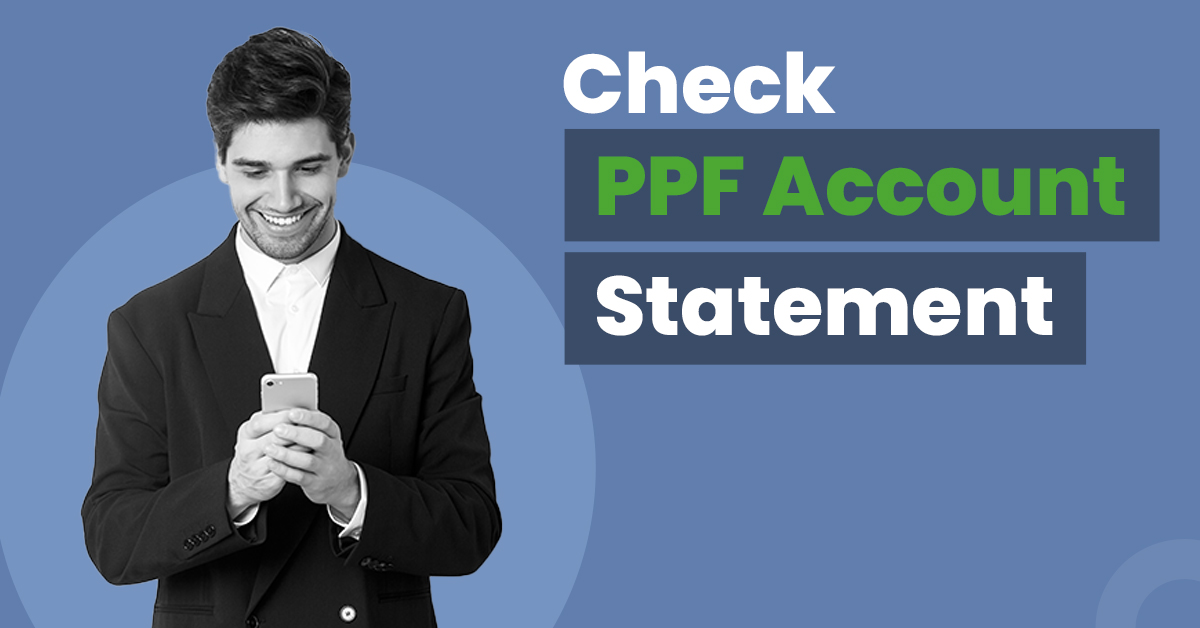How to Check PPF Account Statement


Public Provident Fund (PPF) has been a preferred traditional investment channel for creating long-term wealth. The government-backed scheme, which has a maturity period of 15 years, ensures that your capital investment remains safe and you get a higher rate of interest than fixed deposits.
Moreover, one of the critical benefits of a PPF account is the triple exempt (EEE) tax status — the contribution towards the PPF scheme (up to ₹1.5 lakh), the annual interest earned, and the corpus withdrawn at maturity are all tax-free. It is easy to check your PPF account to monitor the returns regularly. This article features a detailed guide on accessing your PPF account statement, initiating a partial withdrawal from your PPF account, and more.
Steps to Check PPF Account Statement
As the Public Provident Fund Scheme is a long-term investment, it is essential to keep track of it on a regular basis. You can request PPF account statements using online as well as offline methods.
Check the PPF account statement online
You can access your PPF account statement online if the account has been opened through a bank. Here are the steps to follow:
- Step 1: First, you need to link your PPF account with your savings or current bank account.
- Step 2: Ensure that your bank account has an active internet and mobile banking facility.
- Step 3: Log in to your bank account using the internet or mobile banking.
- Step 4: You can check your PPF account status and request an account statement online.
Through the online method, you can also avail of additional services such as transferring funds into your PPF account, setting up auto-debit instructions for regular investment, requesting a loan against your PPF account, etc.
It is important to note that the online facilities and services mentioned above may vary for different banks. If you have not activated your internet and mobile banking facility, it is advisable to do so. Your bank will give you the login and initial password to begin the process. With the help of net banking, you can quickly check your PPF account statement, submit a fund withdrawal request at maturity, or apply for a loan. It is an efficient method to check PPF account statements online.
Check PPF account statement offline
In case you choose not to activate the net banking facility to check your PPF account statement online, you can do so by visiting the bank branch. Following are the pointers to keep in mind while accessing your PPF account statement offline:
- You get a passbook when you open a PPF account through a bank. The passbook contains all the relevant details, such as account number, balance, details of the branch, and debit and credit transactions in your PPF account.
- To check your PPF account statement, you need to visit the branch and get the passbook updated periodically.
- The updated passbook will showcase the latest PPF account statement with all the relevant details.
- Similarly, if you have opened a PPF account through a post office, you must physically visit the branch with your PPF account passbook to access the PPF account statement.
Checking the PPF account statement through the Post Office
Individuals living in remote locations far away from the comfort of financial institutions can check their PPF account statements through the post office as well. You will have to approach the post office where you’ve opened your account and get your passbook updated regularly to keep track of your statement.
How to Make Partial withdrawal from PPF Account?
Even though PPF is a long-term investment instrument, the government allows you to withdraw a certain amount. However, you need to fit the eligibility criteria before applying for partial withdrawal. The conditions are as follows:
- Your PPF account must be active for at least five consecutive financial years.
- You can only make one partial withdrawal request in each financial year.
- Before making such a request, you must repay any outstanding amount, in case you have taken a loan against your PPF account.
As per the PPF Account Regulations, the maximum amount you can withdraw in a financial year should be lower of the two:
- 50% of the total account balance at the end of the fourth financial year preceding the year of withdrawal.
- 50% of the total account balance at the end of the preceding year.
One of the most significant advantages of partial withdrawal from the PPF account is that it allows you to ease your financial burden without entirely relying on loans. Moreover, the amount withdrawn is completely tax-free.
To make a partial withdrawal from your PPF account, you need to follow the steps given below:
- Download the PPF withdrawal form – called Form C – from your bank’s website. You may also visit the bank branch and physically collect the document. You will find three sections that need to be filled:
- Declaration: In this section, you need to provide the details of your PPF account and the amount you want to withdraw. Also, you need to declare the years the PPF account has been active.
- Office Use: Fill in the details such as account opening date, current total balance, date of last withdrawal (if applicable), etc.
- Bank Details: You need to provide the bank account details to facilitate the credit of the amount being withdrawn.
- Attach the copy of the latest PPF account statement or updated passbook along with correctly filled Form C.
- Submit these documents to the bank branch.
The bank will assess your application and sanction the withdrawal amount per the regulations. You can opt for a direct bank account credit or a Demand Draft to get the amount. You must mention your preferred credit option in Form C, attach a revenue stamp, and sign the form.
Reasons to Check Your PPF Account Statement
Estimating Maturity Corpus: By closely monitoring your PPF balance, you can effectively gauge the total corpus you will accumulate at account maturity. This foresight can be crucial for long-term financial planning and achieving your investment goals.
Loan Eligibility Insights: Understanding the balance is crucial for those needing a collateral-free loan against their PPF account. Eligible between the 3rd and 6th year of the tenure, the loan amount you can avail is directly related to your account balance. Specifically, it’s up to 25% of the balance in the account at the end of the second year preceding the loan application year. Regular balance checks inform you about your potential loan quantum, aiding in managing immediate financial needs without hassle.
Understanding Withdrawal Limits: PPF accounts offer the flexibility of partial withdrawals post the 5th year of investment. By consistently monitoring your account balance, you gain clarity on the maximum amount you can withdraw, ensuring informed financial decisions.
Tracking Interest Accumulation: Regularly checking your PPF account balance is essential to stay informed about the interest earned annually. The interest rate, set by the Finance Ministry, is subject to quarterly revisions. This means the interest on your deposit varies throughout the investment period. Monitoring your account helps you understand these fluctuations and the cumulative interest credited each financial year.
Conclusion
Opening a PPF account is a great way to start your investment journey. Your capital is secured, and you generate guaranteed returns over the tenure. Moreover, with the EEE tax status, you also save on your income tax. As you now know, accessing your PPF account statement online and offline is very easy. You simply need to log in to the Public Provident Fund account through net banking or visit the nearest post office or bank branch and update your passbook.
FAQs
Can I log in to my PPF account?
Yes, you can log in to your PPF account online through net banking. However, please ensure that your PPF and bank account are linked. With the help of internet banking, you can view the PPF account balance, add funds, and apply for a loan or partial withdrawal online.
Can I get a PPF passbook online?
PPF account statements can be accessed online through net banking. The latest statement will serve as the passbook of your PPF account.
How much can I withdraw from PPF after five years?
The maximum amount you can withdraw from your PPF account after five years is capped at 50% of the total account balance at the end of the last financial year or 50% of the total balance at the close of the fourth financial year, whichever is lower.
What is the maturity period of a PPF account?
The maturity period of a PPF account is 15 years, and you can choose to extend the tenure in blocks of five years.
Can I close my PPF account before 15 years?
Yes, you can close your PPF account before 15 years. However, it can be done so only under special circumstances, such as if you need the funds for a medical emergency, your child’s education or if there is a change in your residence status.
Can I withdraw all my money from PPF after 15 years?
Yes, the money can be withdrawn in full after its maturity period.
When can partial withdrawals begin?
Partial withdrawals can be made, from the start of the 7th financial year after the account has been created.
How do I apply for the Public Provident Fund (PPF) Amendment Scheme, 2016, through SBI?
To apply for the PPF scheme, you need to fill Form A and submit it at any SBI branch with relevant documents.
What is the eligibility for investing under the Public Provident Fund (PPF) Amendment Scheme, 2016?
A PPF account can be opened by resident Indian Individuals and individuals on behalf of minors. Only one account can be maintained by an Individual, except an account that is opened on behalf of a minor.



